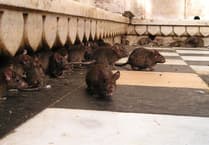Pembroke Castle is about to undertake its first archaeological dig for over 70 years. The Castle Studies Trust has awarded a grant to Historian, Neil Ludlow, and Dyfed Archaeological Trust to excavate an area of the castle grounds where it is believed a building dating back to the Tudor era once stood.
It is hoped that the work will reveal the extent, age and purpose of a building which could well have been the birthplace of King Henry VII, the founder of the Tudor Dynasty.
Tantalising glimpses of what lies beneath the surface were revealed in aerial photographs in 2013, with parch marks revealing the outline of a possible late medieval double-winged hall house.
This was further confirmed by geophysical surveys carried out by Dyfed Archaeological Trust, funded by the Castle Studies Trust, in 2016.
Under the guidance of well-known castle expert Neil Ludlow, Dyfed Archaeological Trust will put in two trenches to understand more about the form, date, context and function of the remains.
Additionally, they will do a topographic survey to make a detailed record of the layout of the castle.
Neil Ludlow said of Pembroke: “The geophysical survey carried out in Pembroke Castle, in 2016, funded by the Castle Studies Trust, showed a large, winged building that resembles, in plan, a late-medieval manor house. This is an unusual find within a castle, and has additional significance at Pembroke as the possible birthplace of King Henry VII.
“But this is still guesswork, as nothing else about the building is known. All we really know is that it was excavated in the 1930s without records. Thanks to the support of the Castle Studies Trust, some of these questions will be answered as well as learning more about later medieval high status living.”
Castle Studies Trust chair of trustees, Jeremy Cunnington, added: “Pembroke is a major monument, but one not in state care and therefore has not been studied in the same degree of detail as many other castles. The Trust is delighted to be able to fund further work on this iconic site and learn more about its hidden past.”
Castle Manager, Jon Williams explained how the hot summer weather has further revealed the parch marks this year and added: “Our visitors have all been asking about the marks on the ground, and it has been nice to be able to explain that we are now going to excavate the site.
“It is very exciting for us as nothing like this has been achieved in the castle since the 1930’s”.
The work will take place during the first two weeks of September and visitors to the castle will have a good view of the excavation as well as having an opportunity to talk to those leading the excavation and the volunteers who are involved.




